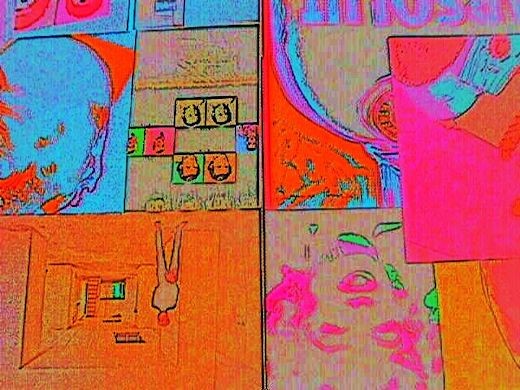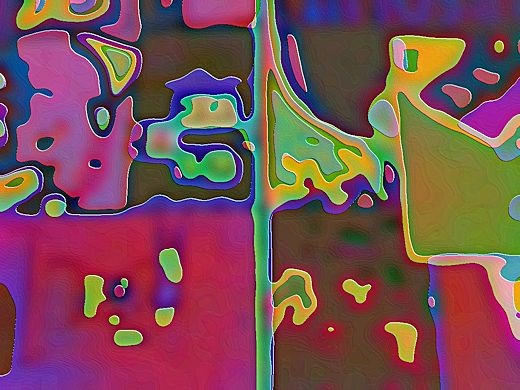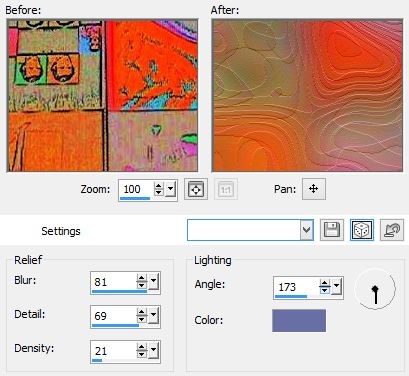quondam those are nice paintings. Now, I don't want to question how you did them. You could have done them on a xerox machine as far as I am concerned. For me, you have 50 prints, I look at them as one show and I appreciate each tile as it has its own bayou. So I played and enjoyed. PE is also reasonable to ask you and I to stop and get into the building as we might do with paintings on the wall or sculptures in the space. At that point, of course, he is delightful, smart, interesting, even diagonally spiritual and all that. He is also pointing to obvious contentions.
--Orhan Ayyüce
I think archigram did a good job of identifying a design problem and then through collaging, drawing, cut and paste, many different iterations, dug for some really unexpected and interesting solutions. Peter Eisenman wants the history of architecture to be the prima materia for deconstruction. Peter Cook will take anything from the world, the hans hollein 'everything is game for architecture' to discover an idea.
--domestico
2016.05.30 09:44
“Technology is a cruel tool" -Peter Eisenman
domestico, you describe a/the very sensible way that many alternatives engender value judgment, and I agree with all that you've written here. Your compare/contrast of Eisenman vs. Cook seems especially relevant. Overall, your answer to " what happens when your judgment says you like all of them?" is correct in that indeed "the judgment has to be in relation to the design problem that initiated the search."
What I was more trying to demonstrate with the images/'alternatives' above is the creative joy (for lack of a better term) that comes with algorithmically generating many alternatives. It's fun and exciting, and, more importantly for design, visually and mentally stimulating. Yes, algorithmically generating many alternatives is perhaps only the fun and easy part of design, but, as the design development work begins, perhaps/hopefully the visual/mental agility of the alternative phase is carried through into the value judgments of the design development phase. Who knows, it could already be that good designs render value judgments algorithmically.
Orhan, how the images were produced is likely the most relevant (of your) question(s) to this discussion. A group of existing images were each subjected to an existing graphic effect algorithm (in this case 'enamel') all with the same parameter settings--relief blur=41, relief detail=7, relief density=68, lighting angle=158, lighting color=R67G95B174. I didn't write the algorithm, but I did make a value judgment as to the parameter settings. It really is fun to see such dramatically transformative results so quickly and easily, and I very much wish I was knowledgeable about the algorithms utilized by younger architects so that I could dramatically transform existing architectural computer models just as easily.
And, for the sake of example, this image, which is already an algorithmically altered image...


which is the first image of the group before.
| |
2016.05.30 12:26
“Technology is a cruel tool" -Peter Eisenman
chatter of clouds, you're very astute as to the base process behind my 'algorithmic alternatives'. It always begins with the aleatory, which in turn begins the value judgments. I save the parameter setting that please me, and then continue to learn more about the effects of the various parameters by tweaking the numbers, which in turn calls for more value judgments. But, yes, it all starts with the 'throw of the dice', which is actually an option already written into the original graphic(ally transforming) algorithm.
Chance seems to be anathema to the architectural design process, or at least anathema to way architectural design is for the most part taught. In now thinking about the aleatory and how it might relate to architectural design (I suppose especially with regard to designing with algorithms), and with regard to what you just wrote about the algorithmic already being part of Eisenman's design process, here's something from the forum (13 years ago which no longer exists):
2003.09.26 17:02
architecture and accidents
"...check out some of Peter Eisenman's work. It has an accidental quality--he sets up processes and systems and kicks back and waits to see what happens."
As just described, Eisenman's methodology is then a process of intended serendipity rather than a process of pure accident.
2016.05.30 20:03
“Technology is a cruel tool" -Peter Eisenman
Orhan, I don't think the numbers (of the parameter settings) have any narrative connection, except, for example (in some cases) the higher the number, the more intense the result. Otherwise, I'm not sure what you're getting at.
Olaf, value judgments can't happen until there are (at least) 50 alternatives. ;-)
2016.06.01 08:40
“Technology is a cruel tool" -Peter Eisenman
For me, it's been using the 'randomize parameters' button...

...an option I'm familiar with since 1995.
| |
2016.06.02 10:37
“Technology is a cruel tool" -Peter Eisenman
2005.12.02 11:35
Consumerism and Monumentality (a thread started by Olaf under another name)
I agree that there is a kind of hegemony operating within architecture today (and definitely since the Modern Movement/International Style), but architecture wasn't always that way. Most of architectures' histories are like languages' histories in that they were all tied/related to specific places on the planet and reflected the culture of those places.
Reflecting on what presently constitutes architectural "history," perhaps architecture is now a world trade commodity more than anything else.
Is the next big thing to mix up the fashion brands? Wear your Foster pants with Woods belt over Eisenman panties?
....
As to my use of the aleatory option, the first reason is to find out how the algorithm 'works,' and the images saved are a by-product/record of that learning process. After a sufficient understanding of the parameters and the effects of their range(s), then a more focused tweaking of the parameters comes into play. All the same, I like how the aleatory option is always available throughout any phase of the 'design' process.
2016.06.03 07:25
A girls-only summer camp for aspiring architects and engineers
2000.04.06 12:22
ironically, I never mentioned skin
After I wrote:
"Is not the 'architecture' of the human body an envelope rammed full of 'attributes' that DO NOT show their 'implementation' on the outside? For example, breasts with nipples hardly reflect either the lungs or the pumping heart inside, likewise the one-piece torso offers little 'superficial' indication of two cavities inside. And further, isn't the sublime singularity of the navel very much like the exact opposite of the twisting, turning, asymmetrical intestines just inside? [And just think how literally close the activities within barber shops and beauty parlors come to the activities inside the brain, yet who would dare say that these two activities share the same "function"?]"
John and Van both replied with immediate references to corporal skin. This epidermal connection is appropriate because our skin is indeed our corporal envelope, however, I wish to stress that the examples I used (breasts, nipples, torso, navel, head of hair) where not about skin, but rather corporal design features specific to the body's surface -- yes skin is involved as the predominant material application of these features, but skin is not what predominates the design; our skin is what adapts to the design.
Van also mentioned the sense of touch integral to skin, and this undeniable connection has truly provocative architectural design implications, i.e., envelopes that feel and or respond to contact (or, as inspired by John, building surfaces that (visually) indicate how they are "feeling"). About five years ago, while I was heavily doing research regarding (the theory of) chronosomatics, I came to the conclusion that touch is the first sense to have come into being, and that touch/contact was/is indeed the medium by which "life" itself began. Not only did touch exist before tasting, smelling, hearing or seeing, but, most of all, it was the contact of two otherwise lifeless entities that 'spawned' animate life. Moreover, it can well be argued that tasting, smelling, hearing, and seeing are really only very specialized touch/contact senses. Note also that the sense of touch is not just an attribute of the body's external skin, but a sense indigenous to all parts of the body inside and out.
So what were these two lifeless entities that spawned life through contact with each other? Of course, my answer is that I reasonably assume the true answer may at this late point never re-appear, and that even a reenactment would fall far, far short of the original event. Nonetheless, I believe there is a very significant clue as to the 'scenario' of that first contact right on our own bodies, specifically at the body's extreme external tips, i.e., the tips of our toes and the tips our fingers. It is there that last vestiges of humanity's physical hard external shell still exists, namely our nails, and right underneath our nails are those cross-sections of our body's that are largely just skin. I theoretically propose that this soft entity under a hard entity represents the same conditions that first spawned life. Essentially, it was something soft and vulnerable that found "security and protection" under something hard and more permanent. Animate life began when the contact between the soft and the hard actually became a bond, and thus too the sense of touch came into being.
Now skipping millions of years on the evolutionary scale, I see this soft/hard duality as the beginning of two sexes as well. Contrary to common perceptions, it is the female that is hard and the male that is soft. In simple undeniable terms it is woman that enables embryonic development within her own body -- woman's bodies themselves are hard protective shells (only women corporeally possess and facilitates the human egg that in turn allows fetal development). Men, on the other hand, very much do not have that "built-in" protectiveness, hence men make great displays about forever being on the defensive, and indeed it is almost exclusively men that have continually created our planet's foremost industry, if only to create that protective shell that their sex was not born with -- the age old military apparatus (shields, armor, war ships, submarines, tanks, stealth bomber, etc. are all "man"-made protective shells).
So what then is architecture? Is it a hard, 'simple', 'natural' protective shell that engenders the continuation of life? Or is it a soft formlessness forever (re-)designing an applied shell it doesn't naturally have?
|


